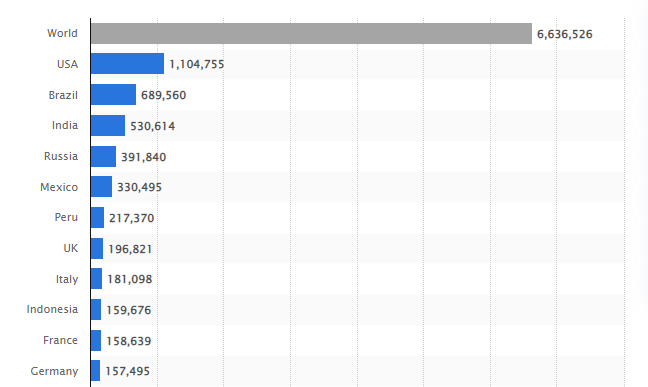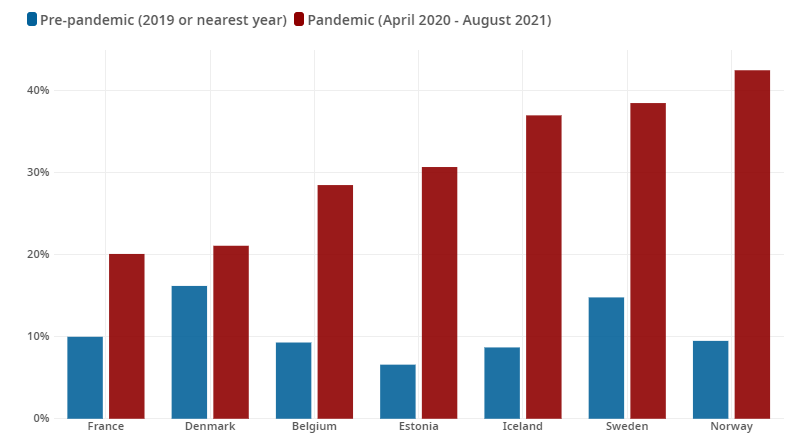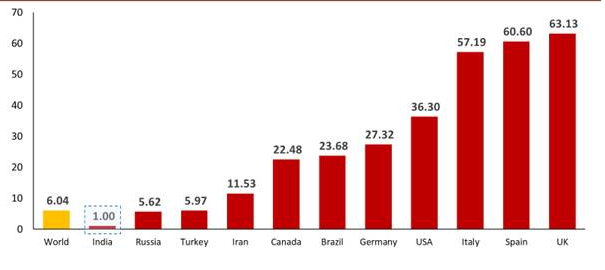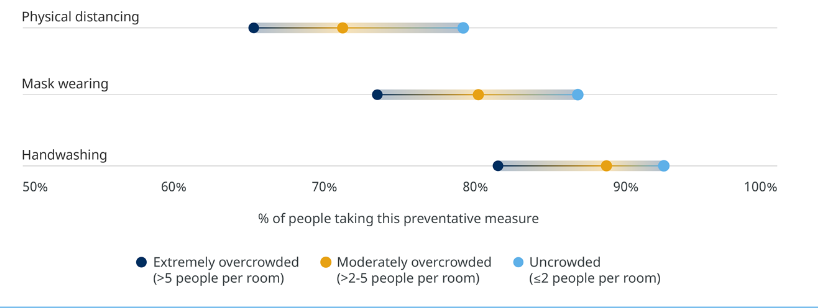BN4410 Health and Safety Management Assignment Sample
Module code and Title: BN4410 Health and Safety Management Assignment Sample
Introduction
Maintaining “health and safety” in the workplace is essential; for increasing the effectiveness of the workplace with increasing productivity. This report is about the findings of the case study of the impact of COVID-19 on the “health and safety” of the workplace around the world. This paper is going to find the consequences of this pandemic around the globe on the “health and safety measurements” of different countries. Moreover, this finds the impact of the sudden outbreak of the pandemic and its causes to increase critical risk factors on the health legislations of a country. The report focuses on evaluating the case based on the perspective of the health vulnerability of the UK and the taken legislation for eliminating the associated risk factor of the pandemic. Thus, it developed the “health and safety concern” associated with the impact of the “COVID-19 pandemic” in the UK and its relevant legislation for controlling the impact within workplace.
Main Body
The consequences of “The COVID-19 pandemic”
The sudden outbreak of the global pandemic due to the “COVID-19 virus infection” created vulnerability in the global health system by creating a shortage of medical services around the globe. This pandemic impacted people’s lives in terms of “mental health, physical wealth, economic situations, social involvement, educational quality, workplace environment, and others”. According to Wang and Wu (2020), it has impacted all perspectives of human life by creating urgency of the requirement of eliminating the risk for removing the health concerns of the people and increasing health and life balance among people. As per the report of WHO, the number of deaths due to the “COVID-19 pandemic” is 1.8 million and the total infected number is 82 million around the world as of 2020 (Who.int, 2021). Furthermore, WHO also reported that “excess death” due to the pandemic is more than 3 million. This death rate has reached 6.6 million as of 2022 and the infection rate reached 646 million in the world in 2022 (Statista.com, 2022).
 Figure 1: Death rate due to COVID-19 around the world in 2022 (Source: Statista.com, 2022)
Figure 1: Death rate due to COVID-19 around the world in 2022 (Source: Statista.com, 2022)
This data depicts the health vulnerability due to this pandemic as it creates a shortage of medical services and health measurements around the world with increasing infection rates with time. Moreover, in this context it can be specified that about 90% of countries faced disruption in their health system during this pandemic in terms of resource allocation, and service provided. According to Moreno et al. (2020), the impact of COVID-19 eliminates social coordinates and physical school absence for education lowers the educational urgency, and increases stress among adults in different countries. As the number of mental health issues among 18 to 29 years of age increases, one in six people registered mental health issues around different countries. Moreover, a total depressed reported 14 million in this age group around the world to increase anxiety among young people due to social exclusion (Oecd.org, 2022). During the pandemic situation, “social distancing” became the new normal that became the reason behind creating distress and anxiety among people.
 Figure 2: Increasing depression among young people after COVID-19 (Source: Oecd.org, 2022)
Figure 2: Increasing depression among young people after COVID-19 (Source: Oecd.org, 2022)
As per the report of the WHO, the UK is the most impacted country as it has seen the highest death rate due to the impact of the “COVID-19 pandemic”. Moreover, the recovery rate in the UK is also lowers which creates health system disruption in the country (Al Horr et al. 2016). About 63.13 million cases were registered in the UK whereas in the US 36.30 million impacted people were registered (Gov.in, 2020). Thus, it generates the disruption and vulnerability of the healthcare system of the UK due to the impact of the global pandemic.
 Figure 3: Impact rate in the UK concerning other countries (Source: Gov.in, 2020)
Figure 3: Impact rate in the UK concerning other countries (Source: Gov.in, 2020)
The impact of the “COVID-19 pandemic” also creates difficulties in providing other critical healthcare services around the globe such as “maternity service, cancer treatment, heart diseases, vaccinations, and others” (Joensen et al. 2020). Cancer treatment and HIV testing have been decided by “26 to 96%” in different countries by impacting their routine healthcare services. Maternity health services have decreased by “5% to 33%” in different countries as per the data of 2020 (Gavi.org, 2022). Moreover, chronic diseases like heart disease, and diabetes did not get the required assistance with the increasing disruption in the regular health care system.
Health and safety concerns
Health concern among people has increased due to the impact and consequences of the “COVID-19 pandemic” as it creates health disruption in every sector and section of life around the world. Moreover, the pandemic has generated associated threats in terms of “economical, social, environmental, and political crises”. This signifies the significant gap in the “health information system” in different countries that creates jeopardy for health services during this crisis (Poplin et al. 2015). As per the report of WHO, about 79% of people strictly maintained physical distancing for decreasing the infection rate, 71% of people avoid overcrowded places, and masks wearing become common to people (Who.int, 2021). This data signifies the increased health concerns among people after the impact of the global pandemic. Governmental bodies in different countries adopted several policies and legislations for increasing health concerns among people by strengthening their healthcare service system. Moreover, workplace safety has become the main concern in the healthcare system as it has faced difficulties in providing the required assistance by doctors.
 Figure 4: Preventive measures during the pandemic (Source: Who.int, 2021)
Figure 4: Preventive measures during the pandemic (Source: Who.int, 2021)
The government has implemented several measures to increase the health concerns of people around the world. Furthermore, the health safety of healthcare service providers decreased as they had to deal with infected people at that time (Betsch et al. 2020). WHO has provided several “concerning measures” of “health and safety” to the public for decreasing its spreading over more people. These regulations are
- Wear a mask inappropriate manner as per the guidance of the WHO.
- Clean your hand regularly and sanitize frequently after touching anything.
- WHO has recommended avoiding 3Cs during this situation such as “closed, crowded or involving close contact” (Who.int, 2022).
- Maintain a proper hygiene system.
- Report to the doctor if feel unwell.
- Take COVID-19 vaccines.
Thus, by providing these regulations, the WHO has created health concerns among people by increasing their awareness of the surroundings and requiring preliminary health measurements.
Relevant legislation
The legislative approaches associated with the health and safety measures in the UK have contributed a great influence towards the lives of individuals and society. During the pandemic session when medicines or vaccines were not available, the government proposed some critical decisions to ensure the health and safety of people along with addressing the environmental parameters (Ahrens and Ferry, 2021). Guidance associated with the corona virus has emphasised two different values these are clinical and non-clinical aspects. The clinical guidance emphasised symptomatic and asymptomatic patients. On the other hand, the guidance associated with the non-clinical aspects covers the restriction on the spread of the virus in public places and government facilities (La Velle et al. 2020). There are also guidance and laws for health professionals that have been addressed by the legal authorities covering the staff with symptoms, investigation and management protocols, and protection values using aerosol and non-aerosol products.
The guidance for sampling and diagnostic laboratories and collection of samples are also provided by the authorities to ensure high safety during the pandemic (Jones, 2017). The concern is to maintain a preventive measure in a systematic way by posing minimum impact on the lives of people. In this regard, the “Workplace Regulations Act 1992” dealing with the health, safety and welfare of workplaces have also been highlighted to ensure sufficient “general ventilation” at the workplaces (Nyashanu et al. 2022). The legal authorises also highlighted the health and safety laws associated with different professional activities to make the environment safer and better for the residents. “The Construction Regulations 2015” is also worth mentioning here. In order to ensure clean air for enlisting adequate “welfare facilities” it is essential.
On the other hand, is also essential to prevent people to meet the contagious virus during their work conditions. In order to curb the spread, it has been ruled by the legal authorities to put a stopper to public engagement (Sanders, 2020). Despite that, there are some necessary services has been needed to go on of which the employees associated with these sectors must come to the work premises. The authorities also referred to “Control of Substances Hazardous to Health 2002 Regulations (COSHH)” to address safety precautions for preventing contamination. Generally, in this scenario it can be evaluated that people working in the research laboratory with the virus to develop vaccines, working in health centres for treatment and others have been under tremendous threats of getting infected (Scally et al. 2020). Therefore, the legal authorities also have ruled in favour of these employees to provide them with maximum safety. In this regard, “The United Kingdom Health and Security Agency” provided vast guidance associated with COVID – 19 vaccinations where the people with high vulnerability are prioritised first.
Evaluation of health and safety management concerns
The primary aspect of the health and safety management concerns associated with COVID – 19 deals with proper control over the spread of the virus, ensuring normalcy and sustaining people’s needs. The potential for securing a sustainable drive in building a strong health standard relies on the shoulders of the legal authorities, health workers, and general people (Pranggono and Arabo, 2021). The preventive actions deal with proper health facilities, ensuring continuity in medicinal supplies, and enlisting advanced systems and machinery for the management of safety protocols even in the engineering and construction firms. These are the subjective measures of legal and professional organisations. The country has been reported to obtain 240 Million cases and 2120000 deaths have already taken place due to the virus (Richardson and Lovegrove, 2021). In this regard, the severity of people getting sick, and succumbing to ultimate fate have to be minimised to prevent social and economic downfall.
There is certainly historical evidence of the countess’s death from the pandemic in the region for example 1919 plague while the people of the 21st century never experienced anything like that till the emergence of COVID – 19 in 2020. It has been the primary responsibility of the legal authorities to spread awareness on self-protection alongside social protection to keep the health and safety of the common people (Divala et al. 2020). In this context it can be stated that it all started from the community level and thereby emerged to the national interests or concerns. The health and safety concerns comply with some protocols to be followed concerning the complexities of the pandemic (Heald and Hodges, 2020). The factors included in this regard are staying up to date with the vaccines, improvement of ventilation, getting tested when needed, keeping a safe distance by staying at home and others.
There is also certain guidance provided by health professionals when the symptoms of the disease become prominent. It is not only for personal sake but it is also associated with the safety of others. Deep sense, sensitivity and empathy for social values have been given priority by the legal authorities and all the concerned organisations like WHO in this regard (Zaga et al. 2020). Due to the lockdown, the organisations providing health services face many challenges to collect resources at the time of need. The requirement included human resources, technical support and resources like funds, medicines and medical equipment. The pandemic has clarified despite significant development in the medical field; there is still a requirement for a lot of development.
With the rigorous effort of people, legal authorities, health workers and other associated role players, presently the vaccines have been developed within a short period and distributed to a vast population (Pilbeam et al. 2016). Due to the emergency, vaccines skipped their trial stages, which also have a certain critical impact on the health standard (Cowie and Myers, 2021). Under certain circumstances, people have become immune compromised and allergic to the new proteins or genes associated with the vaccines. Therefore, the effectiveness of the medicines like “EVUSHELD” is still a questionable factor for the health and safety evaluation after the emergence of the pandemic.
Discussion (Reflective understanding)
COVID-19 has surpassed the boundary limits and threatened the lives of millions around the globe. The research analysis in this regard has given me the scope to me to understand the health and safety perspectives for dealing with the pandemic in the UK. The subjective analysis has covered many sectors including engineering and construction in the UK and the parallel interface included legal interactions and the role of the health sector to curb the threat. My understanding of the subject is given below –
- The research has covered the rising threats to health and safety due to Covid pandemic the data collected showcased the vulnerability of humanity even with the modern and developed science
- There have been certain difficulties with the data collection, as the research is required to be alighted with the health and safety perspectives of the commercial, legal and health association. The combination of these three, associated laws and their implementation for the research has displayed to me the critical value of authentic data. From the data, I come across that the health, safety measures are still not suitable enough to prevent the adversities like COVID – 19, and proper research in this regard to discover other unknown facts associated with health and safety.
- Even after the emergence, the data showcased people have been negligent to obey the rules and restrictions to curb the spread resulting in a wide spread of the disease and the death of millions. This symbolises that people need to be more agile, aware and educated and must have ethical values in their actions to sustain a proper health and safety standard in the country.
Conclusion
The paper has identified the consequences of the “COVID-19 pandemic” in the world and health measurements around the globe with an understanding of its seriousness. Thus, the paper has developed the consequences of the outbreak of this pandemic and the health impact due to the viral infection. This has evaluated the “health and safety measurement” of different countries with the consideration of the UK and its measurements for tackling the critical situation. At the same time, it has examined the “health and safety concern” after the impact of the pandemic by evaluating the relevant legislation taken for tackling the virus infection. Moreover, the sudden outbreak of this global pandemic shook the “health and safety measurements” all over the world by making critical situations for providing health assistance to every person. It has become critical to provide efficient service to every effective person around the globe that can describe the seriousness of the disease. Thus, the report also gives a reflective discussion for understanding its impact on personal views and health concerns of the surroundings.
References
Journals
Ahrens, T. and Ferry, L., 2021. Accounting and accountability practices in times of crisis: a Foucauldian perspective on the UK government’s response to COVID-19 for England. Accounting, Auditing & Accountability Journal, 34(6), pp.1332-1344.
Al Horr, Y., Arif, M., Kaushik, A., Mazroei, A., Katafygiotou, M. and Elsarrag, E., 2016. Occupant productivity and office indoor environment quality: A review of the literature. Building and environment, 105, pp.369-389.
Betsch, C., Korn, L., Sprengholz, P., Felgendreff, L., Eitze, S., Schmid, P. and Böhm, R., 2020. Social and behavioral consequences of mask policies during the COVID-19 pandemic. Proceedings of the National Academy of Sciences, 117(36), pp.21851-21853.
Cowie, H. and Myers, C.A., 2021. The impact of the COVID‐19 pandemic on the mental health and well‐being of children and young people. Children & Society, 35(1), pp.62-74.
Divala, T., Burke, R.M., Ndeketa, L., Corbett, E.L. and MacPherson, P., 2020. Africa faces difficult choices in responding to COVID-19. The lancet, 395(10237), p.1611.
Heald, D. and Hodges, R., 2020. The accounting, budgeting and fiscal impact of COVID-19 on the United Kingdom. Journal of Public Budgeting, Accounting & Financial Management.
Joensen, L.E., Madsen, K.P., Holm, L., Nielsen, K.A., Rod, M.H., Petersen, A.A., Rod, N.H. and Willaing, I., 2020. Diabetes and COVID‐19: psychosocial consequences of the COVID‐19 pandemic in people with diabetes in Denmark—what characterizes people with high levels of COVID‐19‐related worries?. Diabetic Medicine, 37(7), pp.1146-1154.
Jones, R., 2017. ISO 45001 and the evolution of occupational health and safety management systems. IOSH-Institution of Occupational Safety and Health Paper, pp.1-9.
La Velle, L., Newman, S., Montgomery, C. and Hyatt, D., 2020. Initial teacher education in England and the Covid-19 pandemic: Challenges and opportunities. Journal of Education for Teaching, 46(4), pp.596-608.
Moreno, C., Wykes, T., Galderisi, S., Nordentoft, M., Crossley, N., Jones, N., Cannon, M., Correll, C.U., Byrne, L., Carr, S. and Chen, E.Y., 2020. How mental health care should change as a consequence of the COVID-19 pandemic. The Lancet Psychiatry, 7(9), pp.813-824.
Nyashanu, M., Pfende, F. and Ekpenyong, M.S., 2022. Triggers of mental health problems among frontline healthcare workers during the COVID‐19 pandemic in private care homes and domiciliary care agencies: Lived experiences of care workers in the Midlands region, UK. Health & social care in the community, 30(2), pp.e370-e376.
Pilbeam, C., Doherty, N., Davidson, R. and Denyer, D., 2016. Safety leadership practices for organizational safety compliance: Developing a research agenda from a review of the literature. Safety science, 86, pp.110-121.
Poplin, G.S., Pollack, K.M., Griffin, S., Day-Nash, V., Peate, W.F., Nied, E., Gulotta, J. and Burgess, J.L., 2015. Establishing a proactive safety and health risk management system in the fire service. BMC Public Health, 15(1), pp.1-12.
Pranggono, B. and Arabo, A., 2021. COVID‐19 pandemic cybersecurity issues. Internet Technology Letters, 4(2), p.e247.
Richardson, D.P. and Lovegrove, J.A., 2021. Nutritional status of micronutrients as a possible and modifiable risk factor for COVID-19: a UK perspective. British journal of nutrition, 125(6), pp.678-684.
Sanders, K.B., 2020. British government communication during the 2020 COVID-19 pandemic: learning from high reliability organizations. Church, Communication and Culture, 5(3), pp.356-377.
Scally, G., Jacobson, B. and Abbasi, K., 2020. The UK’s public health response to covid-19. Bmj, 369.
Wang, B. and Wu, C., 2020. Safety informatics as a new, promising and sustainable area of safety science in the information age. Journal of Cleaner Production, 252, p.119852.
Zaga, C.J., Pandian, V., Brodsky, M.B., Wallace, S., Cameron, T.S., Chao, C., Orloff, L.A., Atkins, N.E., McGrath, B.A., Lazarus, C.L. and Vogel, A.P., 2020. Speech-language pathology guidance for tracheostomy during the COVID-19 pandemic: an international multidisciplinary perspective. American Journal of Speech-Language Pathology, 29(3), pp.1320-1334.
Websites
Gavi.org, 2022, “How the COVID-19 pandemic has affected healthcare around the world”. Viewed on: 02.12.2022, https://www.gavi.org/vaccineswork/how-covid-19-pandemic-has-affected-healthcare-around-world?gclid=Cj0KCQiA7bucBhCeARIsAIOwr-9eY_DMHwijWAi6EQ1wOmFFaZXy9odEUCIQRnMaUi2BAlk__-ckEvwaAt-yEALw_wcB
Statista.com, 2022, “Number of novel corona virus (COVID-19) deaths worldwide as of November 28, 2022, by country and territory”. Viewed on: 02.12.2022, https://www.statista.com/statistics/1093256/novel-coronavirus-2019ncov-deaths-worldwide-by-country/
Who.int, 2021, “The impact of COVID-19 on global health goals”. Viewed on: 02.12.2022, https://www.who.int/news-room/spotlight/the-impact-of-covid-19-on-global-health-goals
Who.int, 2022, “Advice for the public: Coronavirus disease (COVID-19)”. Viewed on: 02.12.2022, https://www.who.int/emergencies/diseases/novel-coronavirus-2019/advice-for-public
Gov.in, 2020, “UPDATES ON COVID-19”. Viewed on: 02.12.2022, https://pib.gov.in/PressReleasePage.aspx?PRID=1633577
Oecd.org, 2022, “Building a resilient recovery”. Viewed on: 02.12.2022, https://www.oecd.org/coronavirus/en/
Know more about UniqueSubmission’s other writing services:

